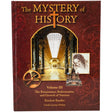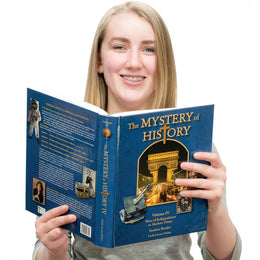




The Mystery of History Volume 3
Renaissance thinkers, global empires, and spiritual revolutions—this volume connects the dots across continents with a biblical worldview and clear, chronological storytelling your teen can truly engage with.
$99.95
Quantity:

Complete Course

Faith-Based

In a Curriculum Kit

Multiple Grades

2025 Ninth-Grade Curriculum Kit
The Mystery of History Volume III Student Reader
The Renaissance: More Than Just Art
The Renaissance wasn’t just a fancy art era—it was packed with power shifts, world-changing voyages, and enough drama to keep any teen wide awake in history class. The Mystery of History Volume III covers the action from 1455 to 1707 A.D.—think the Medicis, Martin Luther, Shakespeare, the Inquisition, Pocahontas, Galileo, and so many more headline makers. It’s all told chronologically, weaving world events and church history into one cohesive, Christ-centered storyline.
Course Overview
Typically counted as 1 full credit of high school history, this stand-alone course doesn’t just drop names and dates—it dives into why they matter. From explosive movements like the Reformation to game-changing discoveries in science, art, and literature, this era is brought to life in a gorgeous, full-color hardback text your teen won’t dread picking up.
Interactive Learning
Some weeks, your teen might be sketching a martyr’s tombstone, making a felt pin like the English did, or creating a “Wanted” poster for Charles II. The Companion Guide (included via digital download) levels up the learning with hands-on projects for every age group, detailed mapping assignments, timeline suggestions, memory cards, and reading lists. Yes, even high schoolers will find activities worth their time—like designing a sundial or researching the wild tale of Jenny Geddes.
Flexible Course Structure
And while Volume III fits perfectly after Volumes I and II, there’s no need to backtrack if you’re jumping in here. It works as a complete history course on its own, with plenty of support to keep your teen engaged and thinking. Best of all, it handles even complex topics with clarity and a respectful Christian worldview.
Conclusion
History that’s bold, beautifully designed, and actually worth talking about at the dinner table? This is it.

Find answers to the most frequently asked questions about this product below:
One difference between the two series is their target age. The Story of the World is primarily for elementary students, with Volume I recommended for 1st through 4th grade and Volume IV for 4th through 8th grade. The Mystery of History's reading level begins at about 4th or 5th grade in Volume I and progresses to 10th or 11th grade in Volume IV, although it is easily adaptable for multiple ages.
Another key difference is the religious perspective. The Story of the World aims to narrate from a neutral perspective. It covers major religious characters and historical events but does not endorse a particular religious view. The Mystery of History is written from a clearly Christian perspective and integrates biblical and church history into the text.
A minor difference between the two series is the student work involved. The Story of the World revolves around the narrative, so all activities, while engaging, are optional. The Mystery of History is also narrative-based but expects more student work. Nonetheless, it is highly adaptable to each student's age and family preferences.









